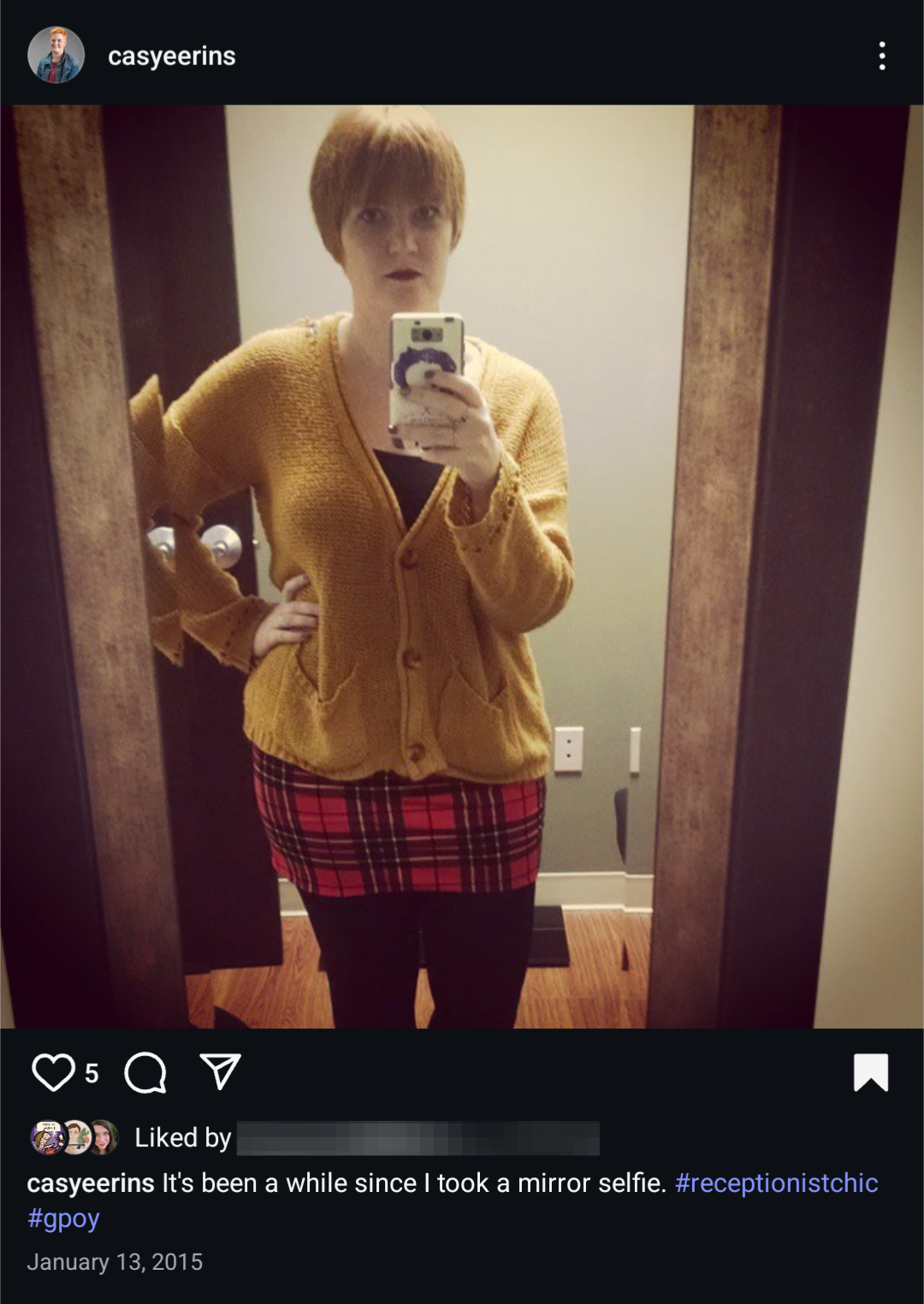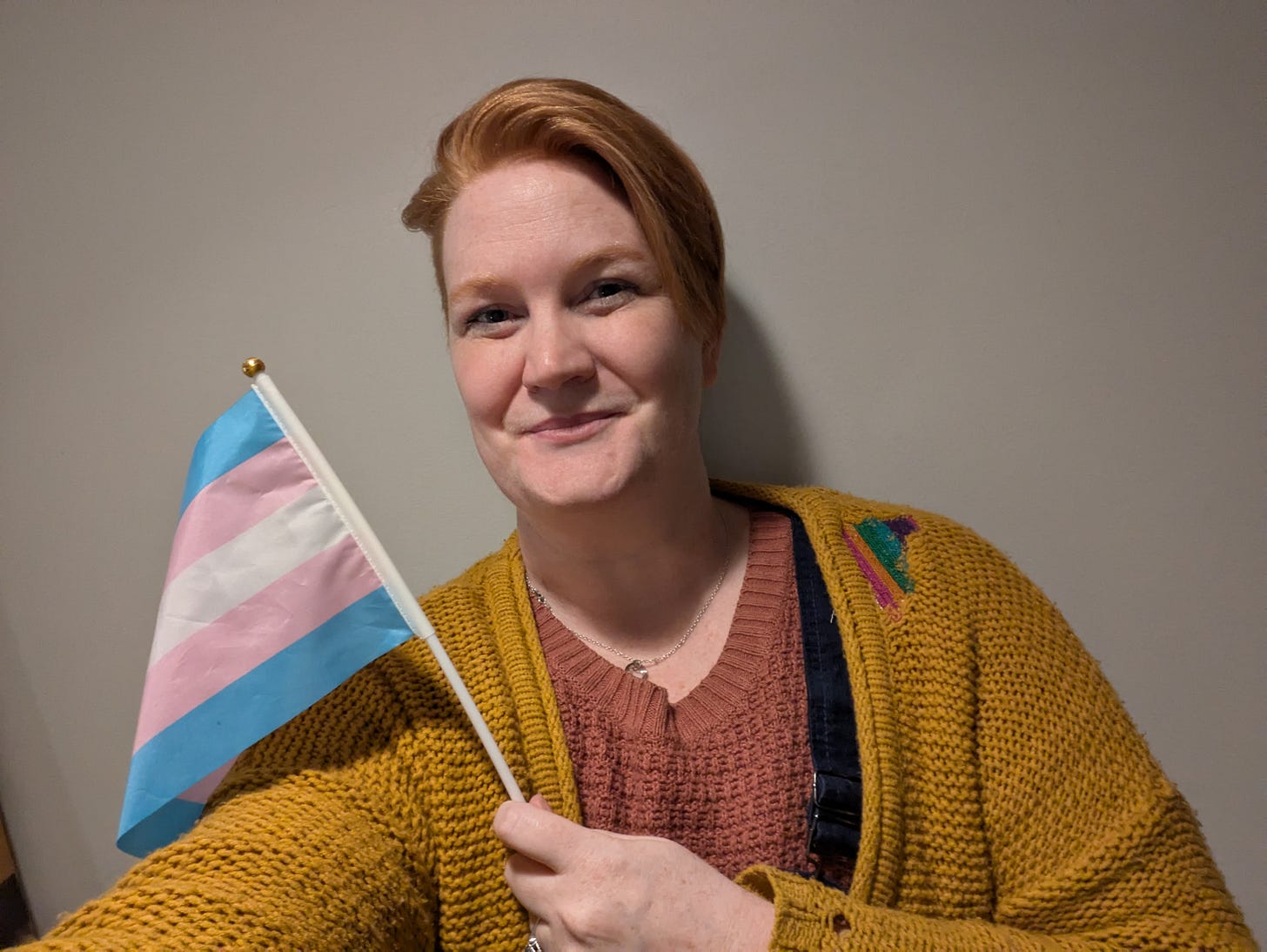Patching a Sweater
Sharing in the Act of Creation
I have this knit cardigan that I've owned for at least a decade. I don't remember where I got it or what I paid; whether it was new or thrifted. Due to what we'll charitably describe as “sensory pickiness,” it has no identifying tags inside or out. The earliest documentation I was able to find of this sweater in my possession comes from Instagram, circa 2015. It's a mirror selfie, and the cardigan is paired with a plaid pencil skirt and knee-high boots to create a look I have no trouble recollecting as being an ode to Clueless’ Cher Horowitz.
The sweater is honey-colored and a little bit baggy, but it's extremely soft and comfy, with big round buttons that clack together in a satisfying way. I call it my grandpa sweater, and, up until recently, I wore it regularly. Ten years is a long time, and it's even longer for an oft-worn sweater. As the parent of two cats, it was inevitable that holes would eventually appear. Sure enough, when unpacking after our move, I discovered two holes in the cardigan: one in the right shoulder and another the size of a softball near the bottom hem.
At first, I was bummed out and resigned myself to taking the sweater out of rotation. My one brief foray into knitting had ended in a hopelessly tangled skein of yarn, and I never learned how to start a second row of crochet stitches. The sweater, it seemed, would be consigned to house clothes until it finally fell apart. I threw it over the back of a chair and forgot about it for a while.
2024 slipped away, and before I knew it, it was a new year–one I hadn't been particularly looking forward to, considering the upcoming inauguration. When Donald Trump was sworn into office on January 20th, he made quick work of scapegoating the transgender community. Every day, news came of another awful executive order, or censoring of government websites. Seasonal depression means winter is hard for me at the best of times, but being inundated with bad news directly aimed at my own community every waking hour made it even worse.
I decided that if I wanted to maintain my sanity, I was going to have to start limiting my time online. That meant finding other ways to occupy myself during a particularly empty period in my calendar. Then Sara Kendzior dropped a piece about crafting to cope with stress in times of crisis. It seemed like just what the doctor ordered.
I dug out some of my wife's cross stitch supplies and decided to patch the sweater. It seemed like an easy enough skill to pick up so (even though I'm pretty confident that it's not a “real” darning method) I pinned a square of Aida cloth behind the holes and set to work closing them with embroidery thread. Knowing that I didn't have the skills to fix the sweater seamlessly, I decided to try visible mending, a technique to repairs clothes in such a way that the mended area becomes an intentional part of the design. Since it was my first time trying cross stitch, I opted to keep it simple by making a rainbow stripe pattern in jewel tones that matched the sweater.
For several days, when I found myself with free time, instead of reaching for my phone, I worked on the sweater. There was something meditative about the process. My mind quieted and I was able to focus on the task at hand. I enjoyed the feel of the needle punching into the cloth, the rasp of the thread dragging through. Seeing the white cloth disappear under rows of colorful thread as I worked filled me with a sense of satisfaction.
At the end of the week, I had successfully patched the holes. Not only that, but I was surprised to find that I liked it even better with the pops of color I had added. It had gone from a common cardigan to a piece with a unique element. In the crafting community, we call these OOAK, which is shorthand for one of a kind.



Despite the simplicity of the project, I was pretty proud of my OOAK cardigan. Not only did it add some much-desired whimsy to my wardrobe, it also revitalized a piece of clothing that might have otherwise been thrown out. I've been trying to make sustainability a big part of my fashion choices over the last few years, so the realization that I could do so in a creative way was immensely satisfying.
The patches aren't perfect by any means. There are some places where I dropped a stitch or where the yarn sticks out. One of the patches has a green stripe in a slightly different hue than the other, because I didn't notice I was using the wrong color until I was too far along. The stitching on the back side is messy and uneven, with a couple of knots where I made mistakes. But it does the job, and the new look suits my sense of style.
It's not hard to draw a parallel here to my experience as a trans person. In the same way I selected the colors and patched the holes, I shaped my own gender identity and expression. Sometimes it was frustrating, and occasionally it was painful. I made mistakes along the way. There were moments when I wanted to give up, right alongside moments of immense satisfaction. At the end, what I had was one of a kind; something that I created and was proud of, that reflects who I am and what I value.
Today is Transgender Day of Visibility and I know that, like me, many of my trans siblings are struggling right now. I wish I had solution, but all I can offer is the same wisdom that trans people have been passing along since time immemorial. My favorite wording comes from Julian Jarboe, as quoted in his friend Daniel M. Lavery’s memoir, Something That May Shock and Discredit You:
“God blessed me by making me transsexual for the same reason God made wheat but not bread, and fruit but not wine, so that humanity might share in the act of creation.”
You’re an active participant in your own creation, which means that you are the truest version of yourself that you can be. That’s not something everyone can say, and you should be proud. If you can, I encourage you to be as visible as you (safely) can. You never know who you might inspire. Take care of yourselves. I love you.





